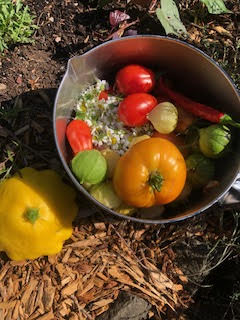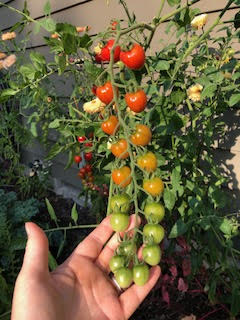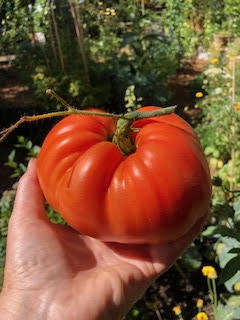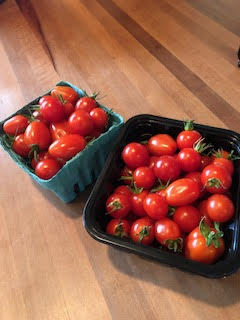I don’t know about you, but I’m itching to get my tomato plants (and other heat lovers like peppers, cucumbers, and squash) into the ground! But, is it time?
Like a lot of us, these 'heat lovers' prefer warm weather and even better, hot temperatures. Wait to plant them until the overnight temperatures are steadily at 50 degrees or above, and where they’ll get a minimum of six to eight hours of sunlight every day (think south facing).
Pictured above left to right: Summer harvests of Orange King and Roma tomatoes, Gardeners Sweetheart, Italian Heirloom.
Depending on your micro-climate by mid-May or Mother’s Day it’s usually safe* to move them from the greenhouse and into mother earth where they’ll be much happier. Don't forget to harden off your starts (gradually acclimating them to the outdoor temperatures) if moving from indoors.
*Transplant tomatoes into the garden when overnight temperatures are steadily at or above 50 degrees, and where they’ll get a minimum of six to eight hours of sunlight every day.

Even after Mother's Day we may still have low overnight temperatures or a brief cold snap. In some cases overnight temperatures are not adequate until the first part of June! Covering your tomatoes with row cover or ventilated plastic will help to protect them by a few degrees and also keep the cold, spring rain off of the leaves.
Whether you’re a first-timer or just need a refresher, here are a few tips to have a successful harvest:
Best Bet Tomato Varieties
This region’s hardiness zone, number 9a, doesn’t have the long, hot days that It takes for many full-size heirloom and larger varieties to reliably ripen, so if you want to tip the odds in your favor, plant cherry tomatoes and ones that are medium in size. Pollen Yellow Pear, Cherry Buzz, Sungella, Napoli Roma, Gardeners Sweetheart, and dwarf varieties like Tumbling Tom for containers are good choices and currently in stock in the GRT nursery.
Full size, or slicing, tomato varieties can do well here if you choose varieties that are proven to do well in our climate. Purchasing seeds from a local seed company and growing your own starts is one way to ensure you get a good harvest. Or, purchase from a local grower like Growing Roots Together. Some of my favorites that I grow are Orange King, Italian Heirloom, and Super Luscious.
Consider choosing a variety of colors to jazz up your summer salads with minimal effort. Tomatoes and basil have an affinity for one another in the garden and on your plate, and basil also needs warm temperatures so you may want so plant some at the same time.
The Skinny on Determinate vs. Indeterminate
The two main types of tomato plants are determinate and indeterminate. These two terms refer to their growing styles.
Determinate varieties generally don't need a cage, and the fruit ripens over a short period. (Your neighbors
will love you!) These plants will grow to a determinate size, flower, and set fruit and ripen the fruit all at once.

Indeterminate plants like to sprawl and benefit from tomato cages or staking and trellising. These plants will set fruit throughout the season rather than coming on all at once. Indeterminate varieties also benefit from some pruning to keep the growth manageable. Towards the end of summer you will want to prune back new growth and flowers that will not have time to set or ripen fruit.
How to Grow Abundant Harvests
Tomato plants prefer rich, well-drained soil and are heavy feeders. Top dress your garden beds with compost and, if needed, add an organic, water-soluble fertilizer such as Dr. Earth. Use the recommended amount on the package. Check out this post about building soil health!
Plant them deeply so that they will grow more roots and become sturdier. Bury up to 2/3 of the stem, and if they’re leggy, take off the lower leaves and plant them on their side in a trench about 6 inches deep. They may lean a bit at first, but you can be confident they’ll find the sun and straighten up.
Tomatoes like to be watered deeply. Tomatoes have deep root systems that will search for water so water deeply, less often. Tomatoes can even be dry-farmed, meaning using no irrigation! Avoid getting the leaves wet which invites diseases. Water at the base of the plants and let it soak in deeply. Check out this post for a link to a video on watering the garden.
Click the button above to see what's in stock now at the GRT nursery!
Email Marni at GrowingRootsTogether@gmail.com with questions about plants/availability or to talk about a customized garden plan.













댓글